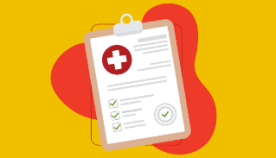AARP Hearing Center


Joy Frank-Collins was at a conference for work in Lyon, France, when her husband, Ethan, mentioned he was feeling tired. A human resources executive by day and a second-year law student at night, her healthy husband had never broken a bone, had surgery or spent a night in the hospital — until weeks later when lab work ordered by his primary care doctor revealed a serious condition.
“He was tracking the blood test results in real time, and none of them were normal. We basically were Googling and not liking what we were seeing,” she says.
Ethan Frank-Collins, 48, is on medical leave from his job in Columbus, Ohio, at a health care organization. Joy, also 48, is a marketing communication specialist for a nonprofit research firm and works remotely full-time while her husband is treated for acute lymphoblastic leukemia diagnosed in November.
“Those first few days, I felt like I had a nest of bees in my chest from that Monday when he did the lab work until we got his diagnosis,” Joy says. “You’re in such a state of unknowing.”
“MyChart (a secure electronic patient portal) is both a blessing and a curse,” she says. “You’re most of the time seeing your results before your doctors are telling them to you, and you don’t have the level of expertise of the doctor to read between the lines. But the longer I’m doing this, I understand more.”


The fear factor
As the couple quickly learned, one of the most stressful parts of any major illness is waiting for test results. How to manage expectations and help a loved one deal with the anxiety-producing waiting game is particularly difficult for those unaccustomed to anything other than the routine test. And there’s no “normal” wait time for a test result because the length of time it takes to get a result is test-specific, including whether it involves tissue samples, imaging, blood work or a culture that needs time to grow. Being patient isn’t easy when those results can mean a life-altering diagnosis or a major shift in health status. “It’s such a huge change in someone’s life overnight,” says Christina Irving, director of client services at the San Francisco-based Family Caregiver Alliance, a national nonprofit.
“Emotionally, there’s a lot for the caregiver and the patient to come to terms with,” she says. “Part of the challenge is the uncertainty of what’s to come — and even understanding what it means for the moment.
“It’s quite common that people don’t feel like they have a good handle on what this means,” says Irving, a licensed clinical social worker. “People might have more access to their medical records, but that does not mean they know what that means.”
Accessing results via a patient portal
A 2022 study, published in the journal Health and Technology, asked individuals about receiving test results via electronic patient portals and found an online preference only for routine test results, such as cholesterol or strep.
Of the 8,030 respondents, 54 percent were ages 55 to 74. The preference for portals depended on the test, as “patients are more likely to feel informed when receiving less serious test results, but more anxious when receiving results from more consequential tests,” the study says.
The study found that even considering a three-week wait for results, patients preferred hearing serious test results — such as cancer, Alzheimer’s or a potential miscarriage — directly from the doctor.




































































More From AARP
Years After My Husband’s Injury in Iraq, I Still Have Caregiver PTSD
Traumatic events can have a long-term impact on a person’s ‘physical, emotional, social or spiritual well-being’
COVID Opens Door to Comfort With At-Home Health Tests
Understanding what the results mean will be crucial
You Can Store Medical Records on Your Phone. Is That Healthy?
Encrypted electronic options for iPhones, Androids weren’t possible a decade ago